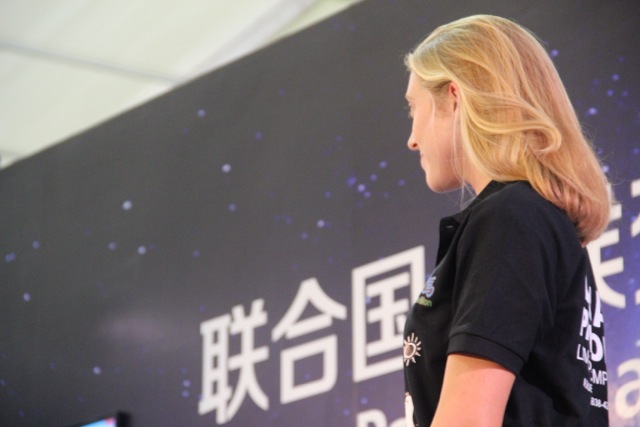This past November, when the news broke of the US-China Joint Agreement for Climate Change I felt strong mixed emotions. I was shocked and excited by the sudden action by two countries who had previously been so reluctant to make definitive strides towards climate solutions, and skeptical of the phrasing—how did these targets add up on the timeline of a warming world? Luckily, many participants at the 20th annual Conference of the Parties of the United Nations Framework Convention on Climate Change (COP 20), which I am attending this week, have done some analysis of the agreement. Climate Action Tracker, for example, recently provided an in-depth report of where these targets stand in relation to our current and needed warming trajectory, which can be found here.
To give some background, COP 20 is an immense international conference to develop critical climate policies which span across economic sectors. Youth environmental organizations attend the COP to put pressure on negotiators to create ambitious, socially equitable, and science-based policies to curb global greenhouse gas emissions and support nations that are most vulnerable to climate disruption during this necessary and imminent transition to a cleaner energy economy.
SSC Delegate Katie Gibson participates in a presentation at the China Pavilion during COP20 in Lima, Peru
On the heels of the historic US-China climate announcement, youth from the United States and China took measures this year to forge strong collaborative relationships in order to build global momentum in the youth environmental movement. On Friday, the China Youth Climate Action Network (CYCAN) invited youth organizers from around the world to present their work on campus low-carbon actions at the China Pavilion at the COP, held this year in Lima, Peru.
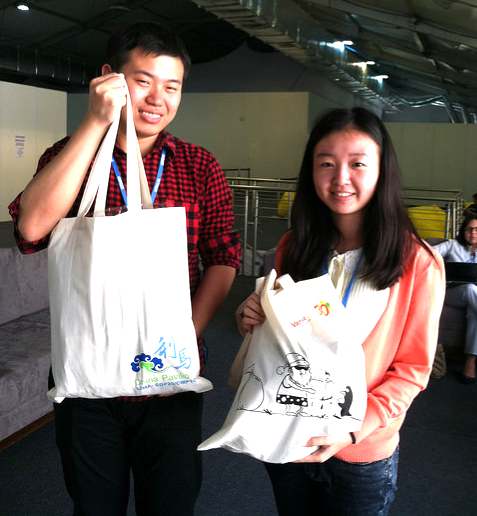
China Youth Climate Action Network delegate members present the SSC with gifts prior to collaborating at the China Pavilion during COP20 in Lima, Peru
The China Pavilion presentation opened with a poignant skit by the Chinese youth, which used a metaphor of two families, one of privilege and one not, who are in the same sinking boat, trying to work out how to resolve the situation given their past contributions to the cause and shared need for mutual responsibility in working towards a solution. To me, the “sinking ship” is a clear reflection of the dynamic of current global climate trends and highlights the need for fast, cooperative action.
Following the skit, members of the Chinese government and honored guests shared some choice words. Li Gao, the Deputy Director General of the National Development and Reform Commission of China, pointed out that over 2,000 lives and $200 billion are lost each year due to climate disruption in China alone and highlighted the need for timely action. Xu Huaqing, Deputy Director General of the National Center for Climate Change Strategy and International Cooperation, described young people as the “thermometer signaling the era,” and Li Yan of the National Center for Climate Change Strategy and International Cooperation, depicted his hope for actions and aspirations of the youth environmental movement, saying, “If you want to harvest, you must first sow the seeds.”

SSC and CYCAN collaboration in action
In addition to CYCAN, Climate Youth Japan (CYJ) of Japan, the Sierra Student Coalition (SSC) of the United States, and Engajamundo of Brazil each presented on the remarkable mobilization efforts of their respective organizations to engage and inspire the youth into acting within their communities. There were several common themes within these presentations. Through developing leadership potential, skill sharing opportunities, and empowering young people to use their collective voice, each of these organizations is affecting positive change across campuses and throughout their communities back home. There was a strong emphasis on educating the public about the issues we face and sharing ways that we can actively and consciously be a part of the solution.
Building on this international youth collaboration, CYCAN and the SSC partnered to write a joint statement to their heads of state detailing the youth reaction to the recent U.S.-China climate announcement and addressing the mutual appreciation for the bold steps taken by both the United States and China, while also pushing for more ambitious goals. In particular, the youth of both nations highlighted the need for strong and effective policies which are socially just and scientifically pointed at their core.
The statement begins, “We, as youth leaders of the environmental movements in the United States and China, come together to express our shared desire for collective action to improve our economies, public health, and infrastructure domestically while also taking cooperative and equitable action to mitigate the shared crisis of climate change.” It goes on to detail the specific emissions targets and policies needed to avert an irreversible climate crisis and warming beyond an ambitious but reachable maximum warming of 1.5 degrees Centigrade above pre-industrial levels. The full statement can be found here: http://www.sierraclub.org/youth/international/statement.
As crucial as it is for the youth— who are inheriting the critical problem of climate disruption—to be a part of the dialogue, this statement is just the beginning. Leading into the COP21 in Paris next year, the unified voices of the world’s youth promise to be there every step of the way, driving progress in their communities and pushing for ever increasing movement towards a world with equitable access to clean, safe, renewable, and socially just energy systems.
By Katie Gibson, Volunteer, Sierra Student Coalition International Climate Campaign
Jóvenes de E.E.U.U. y China en colaboración por el clima en la COP 20 en Lima
Mi reacción fue una de sentimientos encontrados cuando en noviembre pasado los medios de comunicación transmitieron la noticia del Acuerdo de colaboración de EEUU y China en cuanto al cambio climático. Estaba emocionada y a la vez impactada por la momentánea decisión de los dos países que anteriormente se han mantenido reacios en tomar decisiones específicas en cuanto a soluciones al cambio climático, y escépticos cuando se pregunta - ¿Cómo estos objetivos añaden a la línea de tiempo de un planeta que continúa calentándose? Por suerte, muchos participantes en la 20a Conferencia anual de las Partes de la Convención Marco de las Naciones Unidas sobre el Cambio Climático (COP 20), en la cuál asisto, ya han hecho un análisis en cuanto al acuerdo. Por ejemplo, recientemente Climate Action Tracker proveyó un reporte detallado de donde estos objetivos se sitúan en relación a la trayectoria actual del calentamiento global que puede ser vista en el siguiente enlace.
Para ofrecer un poco de información de base, la COP 20 es una conferencia internacional a gran escala que busca desarrollar políticas ambientales relevantes que abarquen los diversos sectores económicos. Las organizaciones ambientales juveniles participan en la COP en orden de ejercer presión a los negociadores para que creen políticas ambiciosas, socialmente equitativas y basadas en ciencia para reducir las emisiones de carbono y apoyar a las naciones que son más susceptibles al cambio climáticos durante esta necesaria e inminente transición a una economía de energía limpia.
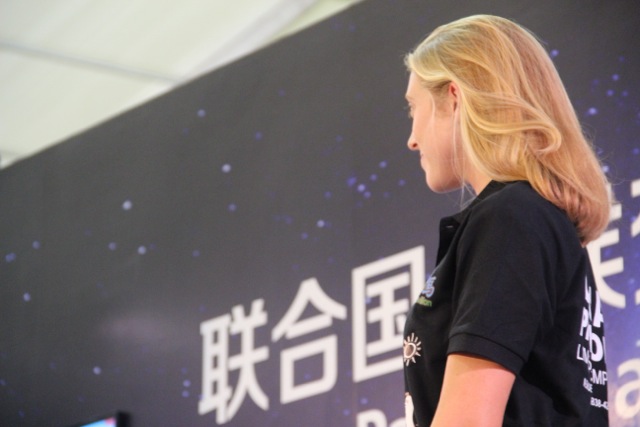
Katie Gibson Delegada del SSC participando en una presentación del Pabellón de China durante la COP 20 Lima, Perú
Ya que nos encontramos en un momento crucial en la historia de EEUU y China en cuanto al acuerdo climático la juventud de los Estados Unidos y China están tomando medidas durante este año para crear lazos de colaboración fuertes en orden de continuar el impulso a nivel mundial en el movimiento ambiental de jóvenes. El viernes la Red de Jóvenes para la Acción Climática (CYCAN) invitó a jóvenes organizadores de alrededor del mundo para que presentaran en el Pabellón de China en la COP las actividades que se están llevando a cabo en los recintos universitarios para reducir las emisiones de carbono.
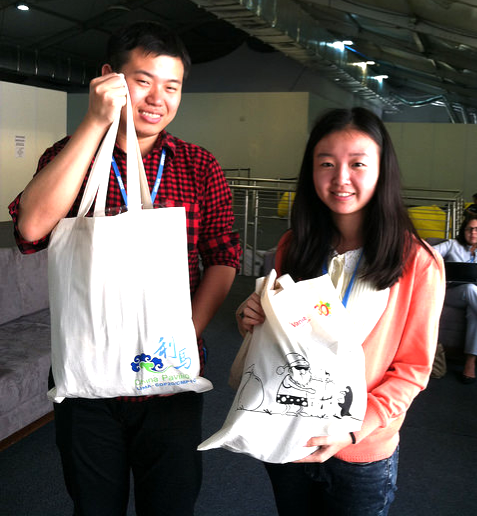
Delegados de Red de Jóvenes para la Acción Climática ofrecen obsequios al SSC antes de la presentación en el Pabellón de China durante la COP 20 en Lima, Perú
La presentación en el Pabellón de China se inició con una conmovedora actuación de parte de los jóvenes chinos utilizando una metáfora de dos familias, una privilegiada y otra no. Estas, se encuentran en un bote que se está hundiendo e intentan resolver la situación en base a lo que han contribuido a la causa y la responsabilidad mutua compartida de encontrar una solución. En perspectiva, el bote que está hundiendo refleja la dinámica existente en cuanto a las tendencias climáticas globales y resaltan la necesidad de que se tome acción cooperativa y rápidamente.
Seguido de la actuación, miembros del gobierno chino e invitados honorables compartieron varias palabras. Li Gap, Subdirector General de la Comisión Nacional de Desarrollo y Reforma de China, señaló que en China solamente se pierden más de 2,000 vidas y $200 billones cada año debido al cambio climático e insistió en que se debe tomar pronta acción. Xu Huaqing, Subdirector General del Centro Nacional de Estratégia para el Cambio Climático y Cooperación Internacional describió a la juventud como el “termómetro que de esta época”, y Li Yan del Centro Nacional de Estratégia para el Cambio Climático y Cooperación Internacional vocalizó su esperanza las acciones y aspiraciones del movimiento ambiental juvenil exponiendo “Si quieren cosechar, primero deben sembrar las semillas”
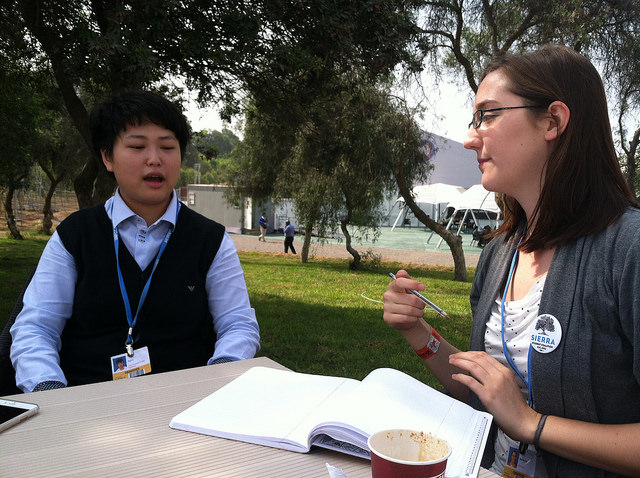
SSC y CYCAN colaborando en actividad
Adicionalmente, CYCAN, los Jóvenes por el Clima de Japón (CYJ), la Coalición Estudiantil del Sierra Club (SSC) de los Estados Unidos, y Engajamundo de Brasil representó cada uno los notables esfuerzos de movilización que están llevando a cabo para inspirar y comprometer a la juventud a que tomen acción en sus comunidades. Entre todas las presentaciones, hubo varios temas en común; y es que estas organizaciones están creando un efecto de cambio positivo en los recintos universitarios y comunidades a través del desarrollo de liderazgo, oportunidades para compartir conocimiento y destrezas, y empoderando a la juventud a utilizar su voz colectiva. Además, hubo un fuerte énfasis en educar al público acerca de las situaciones que encaran y en compartir formas en las que pueden tomar acción y ser parte de la solución.
Cómo parte de esta colaboración internacional de juventud, el CYCAN y el SSC se unieron para escribir una declaración a sus presidentes en la cuál detallaron la reacción de la juventud en cuanto al anuncio del Acuerdo de Colaboración de EEUU y China en cuanto al cambio climático y reconociendo mutuamente los grandes pasos que han tomado ambos países, y a su vez ejerciendo mayor presión para que se establezcan objetivos más ambiciosos. En específico, la juventud de ambas naciones destacaron la necesidad de politica fuertes y efectivas que sean socialmente justas y científicas.
La declaración comienza diciendo: “Nosotros, como jóvenes líderes de los movimientos ambientales en los Estados Unidos y China, nos reunimos para expresar nuestro deseo compartido en la acción colectiva para mejorar nuestras economías, nuestra salud pública y nuestra infraestructura a nivel nacional teniendo también la acción cooperativa y equitativa para poder mitigar la crisis compartida del cambio climático.” El texto entra en detalles acerca de los objetivos específicos de emisiones de carbono y en políticas necesarias para evitar una crisis ambiental y el calentamiento global más allá de los ambiciosos pero alcanzables límites de 1.5 grados centígrados por encima de los niveles preindustriales. La declaración puede ser vista en el siguiente enlace: http://www.sierraclub.org/youth/international/statement/espa%C3%B1ol
Esta declaración es solo el principio para destacar lo importante que es que la juventud- que son los que van a heredar el problema del cambio climático- sean parte del diálogo. En camino a la COP21 en París el próximo año, las voces unidas de los jóvenes prometen estar en cada paso del camino, guiando el proceso en sus comunidades y motivados a crear un mundo justo con acceso sistemas de energía limpia, segura, renovable y socialmente justo.
Por: Katie Gibson, Voluntaria por Coalición Estudiantil del Sierra Club | Traducido al español por: Jahdiel Torres Cabá
